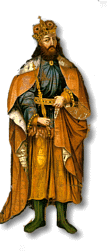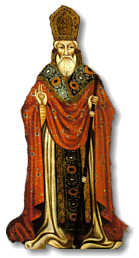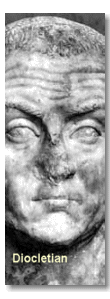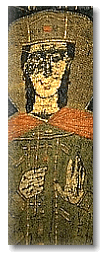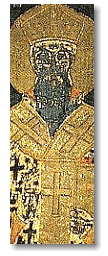The Christian Era
 he
story of Echmiadzin and the beginning of the Armenian Apostolic Church
is tied to the story of King T'rdat III and Grigor of Parthia. Persian
Sassanids had invaded Armenia, killing King Khosrov and eliminating
the Armenian Parthian ruling class. When T'rdat returned to Armenia
in 288 AD leading a Roman legion, he reclaimed his kingdom and attempted
to force the country to adopt the old pagan religion, which was based
on the cult of Vahagan, Anahit and the sun goddess Mythra, which had
been converted by the Sassanids to Zoroastrian fire worship.
he
story of Echmiadzin and the beginning of the Armenian Apostolic Church
is tied to the story of King T'rdat III and Grigor of Parthia. Persian
Sassanids had invaded Armenia, killing King Khosrov and eliminating
the Armenian Parthian ruling class. When T'rdat returned to Armenia
in 288 AD leading a Roman legion, he reclaimed his kingdom and attempted
to force the country to adopt the old pagan religion, which was based
on the cult of Vahagan, Anahit and the sun goddess Mythra, which had
been converted by the Sassanids to Zoroastrian fire worship.
T'rdat--a fervent pagan, began a series of persecutions against the Zoroastrians, attempting to reestablish the old religion. He also participated in Rome's repression against the growing Christian cult. Among his noblemen, and a favorite, was Grigor, the son of the man who had assassinated his father, and who had secretly converted to Christianity at Caesurae.
Legend has it that T'rdat ordered Grigor to imitate other officers in his retinue and place a wreath of flowers before an image of Anahit. When Grigor refused, declaring himself a Christian, he was subjected to torture. Learning that he was the son of the man who murdered his father, T'rdat had him thrown into chains and sent to Artashat, where he was imprisoned for 13 years in a dry well known as Virab.
Armenian tradition dates the official recognition of the Christian faith and the construction of the first churches to the year 301 AD. As with so much of Armenia’s history, the story of Christianity mixes fact with myth and legend, and it is sometimes hard to know the difference between them. But also like so much of Armenian history, the identity of Armenians can be found between the three.
At the time of conversion, Armenia was under the titular protection of Rome, though T'rdat was smarting under the betrayal of Diocletian, who had signed a secret pact with the Sassanids, which did nothing to protect Armenia from imminent invasion by the Persians.
It also launched the systematic repression of
the Christians, who were by now considered a source of social instability.
These were carried out by Diocletian's most trusted general, Galerius,
who was appointed governor of the eastern regions of the empire, including
Armenia.
T'rdat was well known to the Roman courtm and he would have been well
aware of the members of the court who were struggling with the Christian
question. T'rdat would could not help but know of the martyrdom of fellow
courtiers, such as St. George (of slaying the dragon fame).
St. George was a real man, a Roman soldier and close friend to Diocletian. Maybe that's why, when Diocletian issued edicts banning Christianity, George thought that he could change the emperor's mind. He tore down the edict notices and went to Diocletian. Saint George declared that the new law was cruel and against God. Then he quit the army. For this, George was arrested, tortured and finally executed.
We do not know for certain that T'rdat and George
were friends, but it is doubtful they were unacquainted, both being
highly regarded by Doiocletian, and the affect of George's martyrdom
could not have gone unnoticed. It symbolized a groundswell of Christian
support in the innermost workings of the court, and to Pagans would
have seemed like rotting from within, a genuine threat to the entire
empire's religious, and therefore, political structure.
Diocletian's Edicts Against the Christians.
The succession of Galerius, following the abdication of Diocletian in 305 AD, led to particularly severe repressive measures against Christians, inspired by the new emperor's fanatical attachment to the Roman pagan tradition. Tradition has it that after a serious illness during the winter of 310-311, Galerius - having repented his crimes - issued a decree at Nicomedia on 30 April 311 urging clemency for the Christians under his jurisdiction, two years before the more famous Edict of Milan issued by the Emperor Constantine.
Some have thrown doubt on the year 301 AD for Armenia’s conversion, pointing to the improbability of T’rdat—a close vassal of the Roman general—converting his country to Christianity when it would be a direct challenge to Rome at the height of their persecutions. These doubts are given substance by historic accounts noting the official baptism of T’rdat and his court in 311 AD, when Gregory was anointed archbishop at Caesura. However, a deeper look at the political and economic situation in Armenia at the time provides an impetus for an earlier conversion.
The Sassanid's brokered a peace with the Romans and divided the Armenian Kingdom between the two powers after having eliminated the Arshakid ruling class s in Persia. The Armenian King T’rdat was a Parthian-Arshakid, and was related to the Persian Arshakid royal house by generations of intermarriage between the two kingdoms. The destruction of the Arshakid ruling class was a blow not only to the peace between Armenia and Persia; it was the end of blood ties between the ruling houses of each country. As a result of the Sassanid invasion, the Armenian kingdom was in a state of crisis. T’rdat was well aware that with the rise of the Sassanid's in Persia, his own rule was in jeopardy, and eventual invasion of his remaining kingdom only a matter of time.
For several centuries Armenians had shared language, culture and religion with the Arshakid Persians. Threatened with invasion by the Sassanid "barbarians", T’rdat needed to separate the Armenians from their ties to Persia’s culture, or face total assimilation in the new empire. Not to mention annihilation of his own royal house. The immediate threat by Persia was greater than possible repercussions by Romans persecuting Christians West of his kingdom and T’rdat had other influences to turn to the Christian faith.
T’rdat’s grandfather had secretly converted to Christianity. Even during the worst of Roman persecutions, there is no record of a systematic persecution against Christians in Armenia at the time of conversion. In fact, Armenia was considered a safe haven for Christians escaping persecutions. No doubt this created tensions between the Empire and Armenia, precipitating the events of 301-311 AD.
Hripisime and the 39 Virgins
At the end of the 3rd century a group of Christian converts, led by Hripsimeh (called the thirty-nine virgins), who were from the noble Roman class, came to Armenia to escape persecution in the Western Empire. They found refuge, and began preaching the new faith in and around Vagharshapat (present-day Echmiadzin).
One tradition says that Hripsimeh was the daughter of a Roman nobleman, and was to be wedded to the Roman Emperor Diocletian. A Christian, Hripsimeh escaped with Guyaneh and the other maidens to Armenia. Diocletian sent a message to T'rdat ordering him to capture the maidens, offering Hripsimeh as a reward if T'rdat wanted her. If not, he asked T'rdat to return Hripsimeh to Rome so he could have her. Hripsimeh is described in legend as the most beautiful maiden in the empire, and T'rdat fell madly in love with her at their first meeting.
Struck by her extraordinary beauty, he asked her to live with him in his palace. She refused, saying she was engaged to Christ and could marry no mortal. Spurned by her refusal, T'rdat imprisoned her and her followers.
One of the more interesting legends says that with each advance T'rdat was rebuked by Hripsimeh in more and more eloquent ways. Suspecting Guyaneh of coaching escapes from his advances, T'rdat commanded his soldiers to silence the older maiden. They did this quite effectively, cutting off her tongue before stoning her to death. Hripsimeh and the remaining maidens were kept in the palace for several month's while T'rdat attempted to persuade Hripsimeh to marry him. However, Hripsimeh became more and more eloquent in her refusals, finally declaring she could not wed one when she was already promised to another. Furious, T'rdat demanded to know her suitor. "Christ," was the reply, and in a rage T'rdat had Hripsimeh and the rest of her entourage beheaded, their bodies buried in a common burial site.
Just after this, T'rdat became gravely ill , raving like an animal. Medieval drawings and carvings depict his insanity by placing the head of a wild boar on his head, and the more vivid legends interpret this literally to mean he turned into a pig. Actually the depiction is a symbolic one, meaning he had become "subhuman", since wild boars were considered among the most subhuman animal Armenians knew.
The Conversion
T'rdat's sister Khosrovadukht ("daughter of Khosrov"), herself a Christian, then had a dream where she was told that the only way to cure the king and save the nation was to release Grigor. She convinced T'rdat to free Grigor and come into his presence.
Having survived 13 years imprisonment in the virab at Artashat (legends say through the kindness of an old woman who threw bread and drink into his pit), Grigor came before the king in rags covered with the train of his hair and beard. Laying his hand on the head of the king, he is believed to have told the king he would cure him of his madness only if he were to publicly repent of his sins and erect martyria in honor of three of the 39 Virgins (Hripsimeh, Gayaneh and Shoghokat) he had ordered killed. T’rdat agreed, and Grigor cured him.
To show his gratitude, T’rdat agreed to be converted to the Christian faith, together with his family. Grigor, who returned in 310-314 to Caesura to take his vows and, at the same time, to be ordained bishop by the Greek archbishop Leontius, baptized the royal family and its entourage on the banks of the River Euphrates in 311-314 AD.
This date coincides with Galerius’ edict of clemency for Christians in the winter of 310-311, suggesting the official conversion of the state more likely to have occurred in 311,some say 314. The dating is under intense debate.
Others point to a separate set of events that make the earlier date the time of conversion.
These historians point to T’rdat’s decision to convert together with his entire family as a tactical move to preserve his kingdom. By allowing Grigor to become the first Katoghikos (supreme patriarch), it maintained the hold of power within the Parthian class. During the entire 4th century the succession of the Katoghikos was ensured by the direct line of male descendants of Grigor, legitimizing the role of spiritual father of the Armenian Church in the same degree that the male descendants of the Arshacid dynasty were legitimized as successors to the throne of Armenia. It also facilitated solidarity among the feudal nobles of the nation.
Whether in 301 or in 311, the kingdom of Armenia became the first to officially embrace Christianity as its state religion. The Roman Empire did not do so until 380, under the Emperor Theodosius.
T'rdat then became just as fanatic a Christian as he was a pagan, demanding his family, the entire court and military convert as well. When Grigor was ordained archbishop in Caesurae, the entire royal house went with him and were baptized in the Arazani branch of the Euphrates River, at Pakeritch. This precipated 300 years of gradual conversion of the country, referred to as The Pagan Wars.
The Pagan Wars
Whenever it occurred, Grigor (also referred to as Grigor Lousavoritch or Gregory the Illuminator; Surp Grigor or St. Gregory) and T'rdat did team up and began an immediate campaign to squash the old religion, beginning with the Temples of Vahagan and Anahit at Ashtishat in Mush (in present day Turkey). Ashtishat means "place of many gods", and was the primary center for the pagan religion in Armenia. They continued with the temples at Iriz Til Tartan and Ani-Kemagh.
Soon the "crusade" was nationwide. Pagan statues and icons were smashed or melted down, and crosses were set in their place. Of the tens of thousands of pagan statues only a fragment of one bronze statue, the head of Anahit, survives, housed in the British Museum. It is believed by many that among the icons destroyed were all records of the early or old Armenian script , considered pagan and unholy, to be replaced with the Greek and Syrian used in the Christian rites of the Near East. This would be easy to do, since Latin and Greek had become the languages of the court centuries before.
Of the thousand or more pagan temples in Armenia
before the conversion, only one--the reconstructed temple at Garni--survived.
All other temples were demolished, over which new churches were built.
This was the case for Echmiadzin, as Grigor commanded the new church
built over the ruins of the old temple.
The crusade was not always peaceful, with rich and powerful pagan priests
pitted against the Armenian Royal house. Many Katoghikos' were martyred
in this period, among them Grigor's progeny Vertanes, Aristakes, Nerses,
and Husik Petros, who was bludgeoned to death in a dispute over the
construction of a chuyrch.
By converting to Christianity, and then appointing Grigor (also a Parthian)
as the first patriarch or Katoghikos over the Armenian church, T'rdat
insured continued Parthian control over both government and religion.
Later though, a lack of unity between the new Christian ruling class (king, Catolicos and clergy) and the population grew. Some districts readily converted to the new religion, while there were others in which the pagan element was more deeply rooted and involved economic and social interests. Pagan priests, who, thanks to their position had been able to accumulate massive fortunes, controlled large numbers of peasants who cultivated their lands, whom if armed could react to threats to their hegemony. The conversion of the country, imposed from above, did not always take place in a peaceful manner.
T'rdat reigned for 56 years, and after his death, the country was thrown into anarchy. Pagan leaders, who had only accepted Christian leadership out of fear, revolted, and formed an alliance with the Sassanids. The ruling house sent a petition to the Emperor Constans asking that T'rdat's son Khosrov be appointed king. The emperor answered by arriving with a great army and placing Khosrov II (342-350) on the throne.
Christian Kingdoms & the Split
A new capital was built at Dvin, near the river Azat, a tributary of the Arax, and the greater part of the population of Artashat was transferred there. King Khosrov II ordered the planting of a large forest nearby, which he stocked with numerous animals, and which still exists as the Khosrov Nature Preserve.
Khosrov was barely cold in his grave, and the 40-year truce of Nisibi had barely ended when the Persian King Shapur II invaded Mesopotamia and Armenia. With only brief interruptions the war continued for fifty years.
The struggle over religious supremacy continued for 300 years, but was basically decided during the reign of Catolicos Nerses I the Great (353-358), the sixth supreme patriarch of the Armenian Church in direct descent from St. Gregory the Illuminator. Nerses extended the church’s mission to the furthest regions of the kingdom, in which the worship of pagan idols was still very widespread.
While the struggle between Christianity and paganism continued, to the east of the kingdom a new crisis arose. The Sassanids began to make inroads into the Armenian kingdom, bringing with them the Zoroastrian religion (which was based on the worship of sun and fire). King Arshak II (345-367) formed an alliance with the Roman Emperor Julian in an attempt to stay the invasion. Neither Julian nor his successor, Valens, complied with this pact, using the failure of the Armenian Church to recognize the Roman Oriental Church as a pretext.
From its inception, the Armenian Church was allied with the Greek Orthodox faith, the center of Christianity at that time. Using Syrian and Greek texts for the scriptures, Armenian services were far removed from the language of the local population. In addition, there was dissent between the Armenian Church and the Greek patriarch around the interpretation of the divine nature of Christ—was he both man and God, or divine spirit alone?
Struggling with the Sassanid Persian Empire, the Armenian kingdom was also wary of Roman designs, and felt far removed from the doctrinal debates that were held in Caesura and Greece. These debates affected the entire structure of doctrinal supremacy, which led to several schisms between branches of the church over the next centuries, but that between the Armenian Church and the Greek Orthodox church was one of the earliest.
The Armenian Arshacid kingdom was subdivided in 387 by an agreement between the Roman emperor Theodosius and Sassanid King Shapur Ill, to the clear advantage of the Sassanid, who were assigned four-fifths of the territory.
The Alphabet
The Armenian alphabet was one of the key components of preserving Armenian identity in the face of Sassanid incursions and those that followed. Shrouded in myth, the rediscovery of the Armenian alphabet is credited to Mesrop Mashtots, who, under the patronage of King Vramshapour and the Catolicos Sahak Parthev (387-428), traveled to major centers of learning in Asia Minor before "receiving a vision where Christ struck the alphabet on stone".
As the crisis with the Sassanids and the Roman empire deepened, it seems probable that Mashtots—who was the personal translator to the king—was dispatched to uncover the older version of Armenian which Gregory’s campaign against paganism had destroyed.
From Then to Now
Vagharshapat grew in political and religious importance in the 4th c. AD, when the conversion of the country to Christianity expanded and was the focus of attacks by invading armies, including another Persian invasion in the mid 4th c. AD. The attacks precipitated the transfer of the Holy See to Dvin, the new capital of Armenia. Vagharshapat went into gradual decline so that now no vestige of the original walls, the royal enclave or early buildings remain except for sections of the Hripsimeh and Guyaneh martyria and sections of the Cathedral.
The Holy See returned to Vagharshapat in the 17th c, when extensive alterations and renovations to Echmiadzin Cathedral and the surrounding complex were done, and the town experienced a period of revival. As the center for the Church, the city also became the most important center of learning, fostering and sometimes fighting the emergence of some of Armenia's greatest intellectuals. Abovian, Nalbandian, Toumanian, Charents, Hovhanessian, Teghian and Shivardnedzeh were all closely tied to the intellectual currents swirling around the seminaries and schools in Echmiadzin, and collectively they ushered in the modern Armenian literature movement, which pushed the country into the modern age. Echmiadzin was at the center of social change from a feudal society to one based on the European model when the genocide began in 1915.
When the red army invaded Armenia in 1920, Echmiadzin was a center of fierce resistance, and suffered at the hands of the soviets. Churches and seminaries were closed, the Katoghikos Gevorg VI was reputed to have been murdered in 1938, and Vagharshapat went into decline as a city and center of culture.
In 1945 the name of the city was changed to Echmiadzin as Soviets began to lure Diaspora Armenians to immigrate to help build a new country. The city was industrialized and the church was allowed to incrementally expand its work. Under Vazgen I (Katoghikos 1955-1994), the cathedral complex was renovated and expanded along with churches throughout the country. Since Armenia's independence in 1991, the church has begun taking back seminaries and offices confiscated by the soviets, and embarking on a large construction program in preparation for the 2001 AD celebration of 1700 years of Christianity in Armenia.
The name of the city was changed back to Vagharshapat in 1991 when Armenia declared independence, but habits die hard, the city was always vehemently referred to as Echmiadzin by locals and its name was eventually changed back again to Echmiadzin.
History 4
